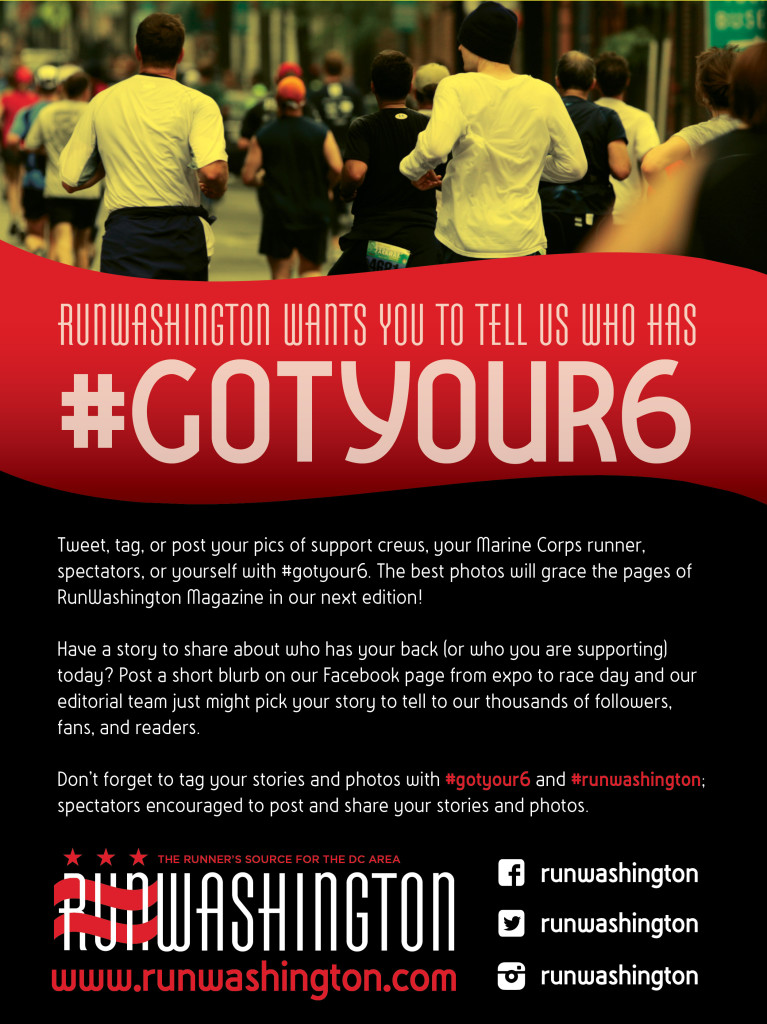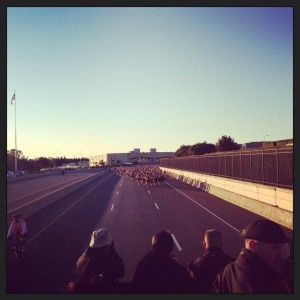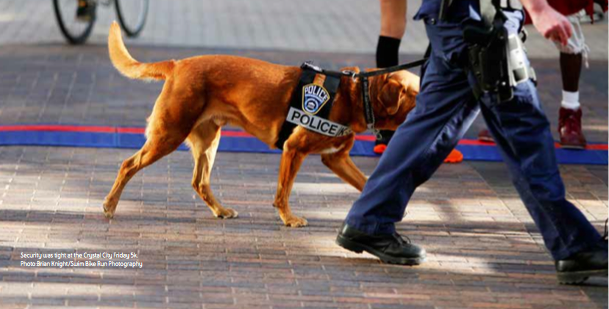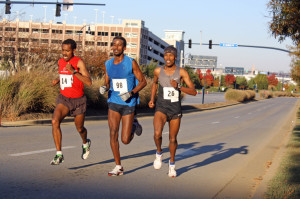
The history of the Woodrow Wilson Bridge Half Marathon is short but impressive.
Four years ago, in its debut year, the women’s race was won by Catherine Ndereba, better known as “Catherine the Great.” In its second year, a new course record was set (1:02:37) and four American men notched qualifiers for the U.S. Olympic Marathon Trials.
The prize purse includes $1,200 for the male and female winners and $600 for top Americans. The race also hosts the Road Runners Club of America National Half Marathon Championships, the Potomac Valley Association USATF Championship and the National Industries for the Blind Visually Impaired National Half Marathon Championships. And with a fun yet challenging course that starts with eight miles on the George Washington Memorial Parkway, climbs over the Woodrow Wilson Bridge, and finishes with a big loop around National Harbor, the race draws more than 3,000 runners of all abilities.
Oh, but those eight opening miles on GW Parkway, a national park …
On day two of the federal government shutdown – four days before the Woodrow Wilson Bridge Half Marathon – Race Director Steve Nearman was forced into making a tough decision.
Due to the shutdown, the race was postponed until November 10, more than a month after the original date. Deferrals to next year’s race were offered and about 600 were processed, Nearman said, while 1,739 runners came out to race on the new date.
Meanwhile, Nov. 10 was as good as Oct. 6 for Kellyn Johnson. The 27-year-old professional runner claimed her second straight win in 1:13:02 and earned prize money in both the overall and American-only divisions.
“It just gave me a little more time to train,” she said. “It was something that was on my schedule before and then it happened to fit perfectly into it after.”
Johnson trains in Flagstaff, Ariz., with Team USA Arizona and said she is still experimenting with distances between 5K and the half marathon. She ran the 5,000- and 10,000-meter races at the 2012 U.S. Olympic Track and Field Trials, and was 4th in this year’s national 10-mile championship hosted by the Cherry Blossom 10 Mile Run. She will return to the area Nov. 17 for the .US National Road Racing 12K Championships.
Johnson was followed by Desta Tadesse of Ethiopia (1:13:53). Waynishet Abebe, an Ethiopian runner who lives in D.C., was 3rd in a personal best time of 1:14:10, just a few weeks after winning the Atlantic City Marathon.
Lindsay O’Brien of Washington, D.C., in her second half marathon, finished 7th overall and was 2nd American. Her time, 1:18:54, was more than a minute faster than her last attempt at the distance.
O’Brien was a three-time cross country All-American at Yale who took a break from competitive running and now trains with Georgetown Running Club.
“I’m trying not to be daunted by the distance,” she said. “This was a good step in the right direction.”
The men’s race was led by a pack of three: Girma Gebre, Siraw Kebede, and Nahom Mesfin, all from Ethiopia.
They raced side by side, charging together up a tough hill in National Harbor. But at the 12-mile mark, Gebre made a strong move to win decisively in 1:04:40.
Gebre has been living in New York with his manager, Alem Kahsay, who said Gebre’s background is in the middle distances. Mesfin, though, is no slouch in the leg speed department, either: He has competed in two Olympics in the steeplechase, and said he spent most of the past nine months training at altitude in Flagstaff, Ariz. Mesfin, however, admitted that Gebre’s move was simply too strong to match.
“Anyway, I’m happy,” he said, smiling after his third-place finish.
The men’s chase pack of four included Georgetown Running Club’s Kieran O’Connor.
O’Connor, 26, has only been running competitively for a few years. But he has already won a marathon and was the 8th American in Boston in 2012. After earning a master’s degree at a university in Cairo, Egypt, O’Connor recently moved to D.C., joined Georgetown Running Club, and – for the first time – started doing speed work under the eye of coach Jerry Alexander.
Going into today’s race, O’Connor’s half marathon best was in the 1:09s. He took it out easy, he said, on the opening downhill from the start in Mount Vernon; men and women were flying ahead of him. But then they started coming back – 5:05 miles clicking away.
At the top of the hill in National Harbor, O’Connor knew his goal of breaking 1:07 was within his reach. And rather than be intimidated by the professional runners surrounding him, O’Conner dropped them on the way to running 1:06:49 – good for 4th overall and top American.
In the visually impaired national championships, Aaron Scheidies, like Johnson, appreciated having extra time to train.
Scheidies won the men’s division last year in 1:18:05. This year, in the week’s before the original race date, Schiedies finished 2nd in the visually impaired division of the triathlon at the London Paralympics. Afterward he took a vacation.
Guided by Georgetown Running Club’s Dave Wertz, Schiedies won his second straight national championship and claimed a new personal best and event record of 1:16:24.
“I didn’t expect it, so I’m really happy with the time,” he said.
Adjusting to a New Race
The Wilson Bridge Half Marathon was supposed to be Briana Whelan‘s tune-up race for the Marine Corps Marathon, her first attempt at 26.2 miles.
When it was postponed, Whelan did not find a replacement race. She nonetheless had a great experience in her first marathon, which she ran with her cousin and uncle.
As for this morning, the Washington, D.C., resident and running newbie ended a two-week break to finish her third half marathon of 2013.
Chris Beeler, a U.S. Army colonel on a year-long assignment in the District, has been training with DC Road Runners and planned to use the Wilson Bridge Half Marathon as a confidence booster for the Army Ten Miler, held on October 20. Her goal race complete, it was hard to stay motivated to run another race, she said.
“But in the end,” she said, “it is what it is, and it was a beautiful day today.”
Miguel Gonzales of Manassas, Va., said the shutdown and the postponement it forced derailed his training. In the 1990s, he ran professionally, but with a busy job and four daughters between 2 and 9, Gonzales – until about a year ago – had more or less stopped running altogether.
“I got to 200 pounds and said I need to lose some weight,” he said. And while today was tough for him and he “felt horrible,” Gonzales said he thought of today’s race as a fresh start.
Mark Geiger of Waldorf, Md., finished his first half marathon, culminating several months of training. He said he could not remember the exact reasons he started running about a year ago – only that he started with walking and, week by week, added a little more running.
“I think it worked out better because the weather today was better,” said Geiger, referring to the rescheduled date.
The weather this morning was perfect for racing. October 6 in Washington, D.C., on the other hand, was a hot day. And let me tell you: This runner has woken up on many such race days and thought to himself: Man, if there’s any way this race could be postponed …
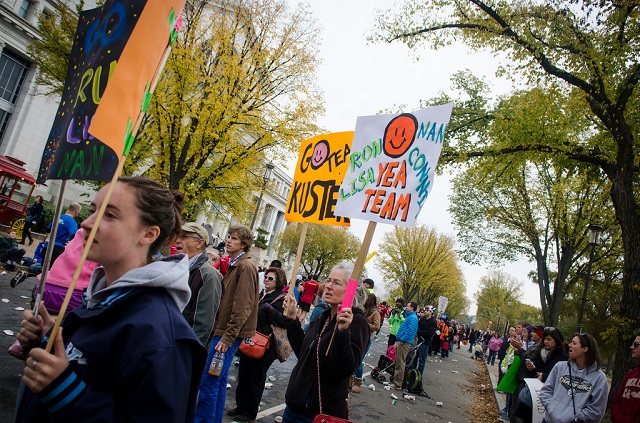
They hold their signs proudly while their eyes scan the road.
It’s not easy: being in the right place at the right time.
All the while they wonder: Do I have their pace right in my head? Did I miss them?
Kimberly Westrich was with her four-year-old son, Freddy. They had their first viewing spot at the Marine Corps Marathon staked out early enough to see the first wheelchair athletes come through.
There they were around the 15.5-mile mark – at the bottom of 15th Street, near the Tidal Basin – supporting Dad (Rick Westrich, 43) during his first marathon.
After a couple hours of waiting, it all happened so fast.
“Rick!” she yelled
He swung back, gave her a kiss. He stepped up off the road, bent down to Freddy and planted a whopper on his cheek.
“I love you,” he said, as he ran off.
Kimberly picked up her backpack, took Freddy’s hand, and the two of them started walking to the corner of 15th and Independence.
Running for a cure
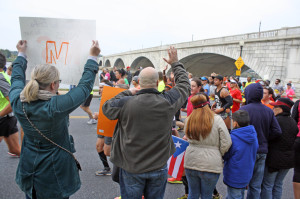
Vanessa Chapman described her daughter, Erika Ross, as her advocate.
Chapman has had multiple sclerosis for eight years. Since the diagnosis, she said, Ross has run or walked to support efforts to find a cure for the autoimmune disease whenever she can.
Ross ran the Marine Corps Marathon for Run MS. And Chapman, to be there with enough time to give Ross a hug before the race, left Baltimore by train at 6 a.m. After wishing her daughter luck, Chapman, who supports herself with a cane, waited for Ross in the family link up area at the Finish Festival in Rosslyn.
While Chapman waited with a friend and her daughter Ashley, Ross’ friends, Emily Downing and C.J. Aldrich, made their way to a spot between miles 10 and 11 on Rock Creek and Potomac Parkway, close to Memorial Bridge.
Ross and Downing have been co-workers for eight years. Aldrich, meantime, said he wanted to return the favor for all the support Ross gave him when he trained for and raced the Marine Corps Historic Half.
Downing’s sign, which she made for Ross, read, “Everyone runs but Erika runs for the cure.” Aldrich’s Halloween-themed sign, which Downing “made for everybody,” read, “It’s scary how fast you are running.”
Downing lives in Silver Spring, and has supported Ross at all of her marathons. That includes two MCMs, but also the New York City Marathon. They also do an MS Walk event together every year in Ocean City, Md.
“Anyone that can run 26.2 miles deserves some support,” Downing said. “If they can run for four hours, I can stand for four hours.”
Downing and Aldrich knew Ross’ goal time was 4:30. As a 4:15 pace group came through, they knew they had to start paying extra-close attention to the stream of runners heading south towards Hains Point.
As Ross ran by with the 4:30 pace group, Downing and Aldrich shouted her name and held up their signs.
Ross, full of pep, threw her hands up in the air as she passed, a sign she was having a great day. In the final miles, she surged ahead of the pace group to finish in 4:26.
When she arrived at the link up area, Ross was all smiles. Chapman, too, showed no signs of fatigue.
“I can’t tell you how proud of her I am,” Chapman said.
The Timelime
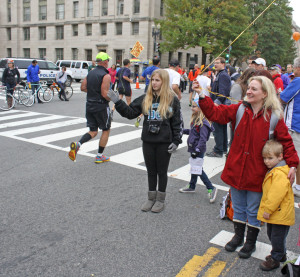
Kimberly Westrich had a plan. Actually, she had a timeline: the way she hoped everything would go plotted out on a spreadsheet.
Kimberly was supposed to get up at about 6:30. But she woke up at her home in Herndon two hours early, around the same time Rick woke up in his hotel near the starting line.
Kimberly and Freddy hit the road at 7:30 a.m. and drove to the Vienna Metro station, where they took a train to the Smithsonian stop.
They were easy to spot. Kimberly, following a tip, bought a balloon so Rick would have an easier time seeing them. The balloon – Freddy’s choice – was Simba from the “Lion King,” and it was attached to at least 10 feet of string.
At 15th and Independence, roughly the 17.5-mile mark, Freddy recognized Ann Schombert and her mother Catherine from their previous viewing spot. He took a shift on Ann’s cowbell and passed it around, while Catherine held up a sign above her head: “Go Tim.”
When Catherine’s brother, Tim Schombert, passed by, he stopped by the side of the road and admitted something that made everyone, including himself, laugh.
“Every muscle hurts,” he said, adding, “my training sucked.”
After Rick passed, Kimberly and Freddy made another very short walk to the intersection of Independence and 14th, just past the 20-mile mark.
Kimberly knew Rick was entering new territory. His longest training run was 18 miles.
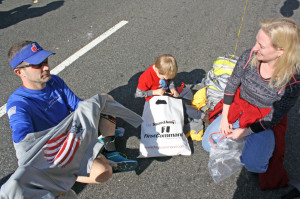
She found a spot in the long line of spectators stretching out towards the 14th Street Bridge. It was a frenzy: with the cheers, the upcoming water stop, the police trying to keep people out of the race course, and the drum group pounding out a relentless rhythm.
Freddy showed no signs of fatigue. He was, however, getting a little antsy – more interested in picking up leaves, it seemed. Kimberly kept Freddy at her side and her eyes on the runners coming around the turn. This was the last chance to see Rick before they headed to Rosslyn.
Simba swirled in the wind, floating up in the air above the runners’ heads. Freddy zoomed in.
And just when the thought crept in – Did we miss him? – there was Rick, giving Freddy a five without breaking stride.
On the way to the Metro, Kimberly – holding Freddy’s hand and carrying a not-light backpack full of dry clothes for Rick, extra warm clothes for them, snacks, water, and a sign she never used – talked about the change in lifestyle that had led to the marathon.
Rick is a personal trainer. They have long been active people. But after Freddy was born, and after many years of on-again-off-again running, they re-committed to running road races, thinking it would set a good example.
Kimberly has run a 10K and is working up to a half marathon. “I just so feel proud of my husband, because he worked so hard,” she said.
In the link up area, Freddy took a seat on the backpack, downed some juice, and settled in, while Rick pushed through the last couple miles to finish in 4:36.
Kimberly got a text. “Done.”
The next one read, “be there as fast as the crowd moves.”
He walked gingerly toward them, compression socks rolled down. He hugged them both and took a seat on the pavement – beat but happy. (“The pain is masked by the accomplishment,” he said.)
Kimberly smiled as Rick put on dry socks and a fresh shirt. Freddy honed in on a video game on Kimberly’s cell phone.
The day had gone according to the timeline.

Four miles into last year’s Army Ten-Miler, Kerri Gallagher surged to catch the lead pack. One of her previous miles had been just under 5:30, a pace she worried would catch up with her late in the race.
The defending champion’s goal this morning was to run 5:30s across the board. Gallagher thought it might be too ambitious, she said. But she also knew, with Olympic trials qualifier Elizabeth Maloy and Olympian Julie Culley entered in the race, 5:30s might simply be needed to win.
Today the 24-year-old, Washington, D.C., resident and Pacers-New Balance runner perfectly executed her race plan: defending her title while setting a new event record of 54:56 – a little faster than 5:30 per mile.
Running a race every year – and having previous years’ results to live up to – can add to the pre-race nerves, Gallagher said during the award’s ceremony. But not ATM.
“The ‘wounded warriors’ are incredible,” she said of the 89 injured service members who kicked off the race 10 minutes before the open start, racing in wheel chairs or running using prosthetic limbs.
“You start thinking of your race and your struggles and then you look up. You think, ‘If they’re doing it, you can do it.’ So it’s really great to feed off their energy. Good or bad race, it’s going to be a good day.”
Maloy passed Culley late in the race to take 2nd in 56:02. Culley, who is training for the New York City Marathon, was 3rd in 56:13.
It was Maloy’s first race longer than 6k, not to mention her first race since the last U.S. Olympic Track and Field trials, where she competed in the 5,000. Afterward, Maloy said she took a long break, and is now enjoying running while working in public relations.
Marathoner Tezata Dengersa was fourth in 56:36, leading her IR4G team in the women’s open team competition. She has now placed well inside the top ten in four straight ATM appearances.
Army Captain Kelly Calway – 5th in 57:06 – also has a history of running well at ATM. A graduate of West Potomac High School in Fairfax County, she finished second here in 2010. She then stepped up her training to finish 25th at the U.S. Olympic Marathon Trials two years later.
Calway had been struggling with illness and injuries. This was her first race since February.
Now her running is back on track. And after running the Marine Corps Marathon next week, Calway said she will be deployed to Kuwait to serve as an intelligencer officer in an infantry battalion.
Brigitta Woodcox, 49, of Woodbridge, Va., was top female master in 58:27, 9th overall.
A Bold Move
(Photo by Dickson Mercer: A big lead pack forms during the opening mile of the Army Ten-Miler.)
In the men’s race, as the lead pack coasted over the 14th Street Bridge with two miles left, Chris Kwiatkowski decided it was time to go.
The 24-year-old, Washington, D.C., resident was in a lead pack with Brazilian Army teammates Solonei Silva, Paulo Paula, and Frank Caldeira, as well as Aron Rono of the U.S. Army and Ethiopia’s Dereje Girma. Tesfaye Sendeku, last year’s champion, and U.S. Army’s Augustus Maiyo, last year’s runner-up and Marine Corps Marathon winner, had fallen off the pace.
“I had to break it open,” said Kwiatkowski, who, like Gallagher, runs for the Pacers-New Balance team. “I had to try and win.”
His move jolted the Brazilians, who took the first three spots in 48:04, 48:06, and 48:08 to sweep the International team competition title. Kwiatkowski, though, held on for 4th in 48:17, a personal best of close to a minute and an improvement on his sixth place finish in 2012.
Brazilian Army Coach Jose Pinheiro said this was the strongest ATM team the Brazilian Army had ever fielded. His athletes, he said, were motivated by the strong U.S. Army teams that won the International Cup three years in a row, before which the Brazilian team won as many consecutive titles.
“They trained to win as a team,” he said. “It is not important to win individually. We trained to do the best we could as a team.”
Caldeira’s 3rd place finish matched his result from 2012. For Silva, who won the race, and Paula, this year’s ATM was their first. But they have plenty of experience racing together, having finished 6th and 7th in the identical time of 2:11:40 in the most recent World Marathon Championship.
Rono was just a second behind Kwiatkowski, and said he was pleased with his result. He finished basic training in March, has been training with Army’s World Class Athletes Program (WCAP) for less than a year, and is getting used to longer distances, he said. Born in Kenya and a graduate of Azuza Pacific University in California, he is now coached by Olympian Dan Browne, a former WCAP runner who won ATM in 2004, 1998, and 1997. (Ray Pugsley, of Potomac Falls, Va., who finished 2nd to Browne in 1998, was the top master today in 53:01.)
“It was really cool seeing the Army guys all along the course,” Rono said. “It is great team building we have in the Army.”
Members of the Fort Myer, Va.-based 3rd U.S. Army Infantry Regiment, known as “the Old Guard,” provide everything from security to the National Anthem. They work at the starting line, run the aid stations, and work in medical tents. They set everything up and break everything down, putting in a 12-hour work day beginning at 3:30 a.m.
“It’s a very complicated effort that we put a lot of energy into making run smoothly,” said Col. James Markert, the Old Guard’s Regimental Commander who led the operation.
Not long before the cannon fired this morning, Markert posed for a photo with his son, James, 15, who ran the race.
It was James’ first race longer than 5k.
“I walked a little bit but I made it to the end,” he said.
There were 35,000 registered runners, including 689 teams. There also were more than 3,000 people running at Army stations around the world. Full team and individuals results are up at ATM’s website.
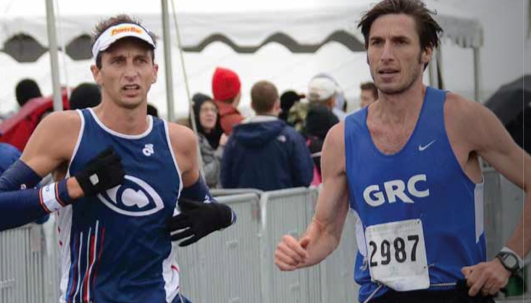
(The Woodrow Wilson Bridge Half Marathon will once again serve as the Visually Impaired Half Marathon Championships)
I don’t know how I want to write this.
I could write that Aaron Scheidies is the best visually-impaired triathlete in the world.
I could write that Aaron Scheidies is a world class triathlete who is visually impaired.
Both sentences, I suppose, are true. And if you go to Aaron’s website, as I did after I agreed to serve as his guide at the recent Woodrow Wilson Bridge Half Marathon, you can go to the “news” section and find many such articles filled with those kind of sentences. Aaron is an amazing athlete. He is as dedicated to his sport as anyone you will ever meet.
But I think, after a weekend spent getting to know this 30-year-old athlete from Seattle, I think what I want to write the most is that Aaron, who in his childhood suffered from macular degeneration, in no way views his blindness as a disadvantage.
To compete at his highest level, all Aaron needs is a guide – someone to watch his path, someone to tell him when to turn, someone to advise him on the tangents, someone to let him know where the water stops and mile markers are and what the clock reads.
Aaron’s guide is not a pacer.
Aaron’s guide, for the most part, is a set of eyes.
Perhaps a month before the race, Jerry Alexander, the coach of Georgetown Running Club, which I belong to, sent out an email encouraging members to serve as guides for participants in the event’s National Industries for the Blind’s championship for the visually impaired. Our club provided guides last year, and many of us again signed on this year.
And to be honest, I can’t remember the exact reason I offered to do it. It was more of an impulse.
But get this:
On Friday, Oct. 5, Aaron, traveling alone, landed at Reagan National Airport on a red-eye flight.
He took the Metro to the Eastern Market stop in Capitol Hill. From there, he planned to walk to the Starbucks on Pennsylvania Avenue, where he would hang out until his host was able to meet up. Our plan, which we had established through email, was to meet up after I got off from work and practice running together.
That morning, I took my dog to the nearest dog park. And as I looked up from unhooking my dog’s leash to let him roam, someone I recognized was walking toward me.
He asked me how to get to Starbucks. As it turns out, he was a just a block or two off course.
“Aaron,” I said. “You’re not going to believe this. I’m Dickson.”
We were flying down the opening downhill from Mount Vernon, a bungee cord wrapped around our waists. He had told me he liked downhills. He would probably get out a little fast, he said, then settle into a pace that felt right.
His personal best in the half marathon heading into the Woodrow Wilson Bridge Half Marathon was 1:20, and from the start he was easily on pace to shatter it.
I ran off his left shoulder.
Fairly quickly, the field spread out across the wide George Washington Memorial Parkway. At times, we ran with someone; more often we were alone, zig-zagging across the road to hit the tangents, for which my guide were in fact the runners ahead of us.
Move a little to the left, I’d say. A little more.
It was cool and rainy; we were both glad we had gone with gloves.
We would lose a little bit of time on the water stops: I would have to swing behind him to his right to grab the cups, and I don’t think I ever quite got it down.
Other than that, things went pretty smoothly. Even better, Aaron was running steady, clocking 5:45s on the more downhill miles and closer to 6:00 on the hillier ones.
The bridge is where this race gets serious. It’s a long climb to the top, the concrete pounding your legs. Then it’s a long downhill, followed by – for Aaron, anyway – a lot of me saying, “Left, right, left, right,” as we snaked back to the final couple miles in National Harbor.
He went through 10 miles in 59:17, and when we hit that big hill in National Harbor, I could tell he was really working – he was there.
He passed Mile 12 in 1:11:30.
“We can break 1:18,” he said, as we hit that off-road stretch sighted runners like to complain about. There were, truthfully, some big rocks in that path, some bumps, some super-tight turns.
I could not really be much help.
“It’s not a big deal,” he said, as he exited the path and made his final half-mile charge towards the finish line in National Harbor.
Those last couple minutes, for some reason, I thought hard about these 13 years – this journey that has taken me all the way from my teens to my 30s, and how ineffably grateful I was to be along for this particular ride.
There are the good races, more bad races. There are the highs, the lows.
But the journey, and the runners, will always be worth it. Aaron crossed the line in 1:18:05. He bent over, spent. I patted him on the back. And having already memorized this particular course, he then guided me to our bags.
Visit www.runwashington.com to hear a podcast about the visually impaired runners who competed at the VI Half Marathon Championships.
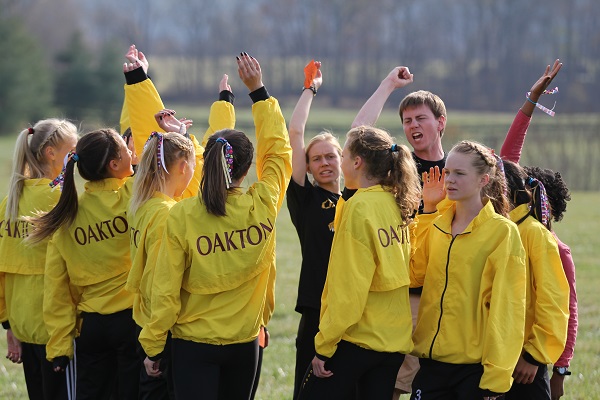
In the 1980s – before Internet forums – Langley High School’s Erin Keogh was the fastest high school distance runner in the country.
Now Erin Breitenbach, she recently did a Google search of her maiden name and said she found these “ridiculous things on some blog.”
Her success, someone wrote, was a product of running an extra 10 miles on top of whatever her team did that day.”I was, like, who has time for that? I can’t run 50 miles a week without getting injured,”she said.
No, Erin Keogh was a visualizer.”I was doing visualization before it was cool,” she said. “I heard this was something people had to learn how to do and I couldn’t believe it. It was so simple. The night before races, I would lie there and go through the entire race in my mind.”
High school running, for many runners,is an introduction to competitive running, but also to running culture, to the wackiness of the sport, and to one of life’s great honors: being on a cross-country team.Visualization was Keogh’s way, in a sense,of keeping herself centered, of embracing the competition without letting it overwhelm her.There needs to be some balance. There needs to be some fun. As runners, coaches and parents around here have figured out, there’s a good time to be had on the cross country team.
An Individual Sport for the Whole Family
When Polly Morgan’s son Tommy joined the cross country team at Chantilly High School,she didn’t think her family would be spending the next six years at tailgates, in horse fields and surrounded by dozens of new friends. Tommy was a basketball player without a team, but he found one as a harrier, even if he wasn’t in the top seven.His brother Bobby followed, and just last year, sister Christie.
Polly saw so many positives in her kids running she rarely knows where to start.
“They come to school part of a social group, and they’re all good kids,” she said. “I don’t think there are many days we don’t have five-to-20 kids in our house. The team is their social life, and it’s one of the few teams that are basically co-ed.”
The nature of distance running, discipline and delayed gratification, were great lessons for her kids, taught and demonstrated in away that didn’t feel forced.
“The team is so supportive of everyone else,” she said. “The kids who are finishing toward the back are as team-oriented as the kids winning the state meet. And the fastest boys cared about how their teammates were coming along.”Though their sons were content running on the junior varsity team,Polly and her husband Tim have a whole new animal on their hands in Christie, who made the varsity team last year as a freshman.”She was a basketball player too,we had no idea she’d be this fast,”Morgan said. “Even though we’ve done this for three years, it’s going to be a whole different experience now.”
K.I.S.S.
Runners need to train. There are no short cuts.
So what is the best way to motivate high school runners to put in their summer training?
“I try to make the summer running as simple as possible for the kids so they don’t have to think,” said Kellie Redmond, the eight-year head cross country and track coach at Wootton High School in Rockville. Redmond puts together training plans for all of her athletes, boys and girls.
Then, since the team cannot practice officially over the summer,Redmond relies on captains like Foster Ting, Declan Devine, Dana Sung, Lexi Levenson and Josh Messing to host unofficial practices.
She has a team listserv, and she’s not above calling or texting or emailing team members who need abit of a nudge.
“But by far I think it is the expectation of the team that keeps them going,” she said.Redmond’s training plans make putting together a summer training plan easy, said Patrick Munro, a rising junior at Wootton and a member ofa 3200-meter relay team that won a state title last spring.Additional structure is provided by the team captains’ sort-of-optional summer training runs.
And it’s fun, he said: “Running with friends is much easier than running alone and helps the distance go by faster. Sometimes we get food after our runs or go swimming. It gives us something to look forward to after.”
Ultimately, Munro added, “The main motivation for me is knowing that whatever I do during the summer will have a direct effect on my season.”
Excel at Forgetting
Michael Murray’s standout performances for Gaithersburg High School in Maryland included finishing second in the state in the 3200 and being a part of an outdoor track team that won the 1998 state championship. He went on to be atop runner at St. Francis University in Pennsylvania, and continues to race at a high level locally while working at the U.S. Department of Transportation.
“You will have plenty of good races and bad races,” Murray advised.”Forget about the bad ones by the time you wake up the next morning.The most successful people I know have a short memory of bad days.”
And be Patient
Dave Berdan of Owings Mills, Md. recently won a marathon in 2:22:19, averaging 5:26 per mile.
A week later he won a road 5k in 14:55 and a 10k in 32:22. At the same event. On the same day.
The Pennsylvania native’s high school best for 5k? Slower than what he averaged in the marathon.
“I definitely think it’s important to not focus on results in high school,” he said, and simply enjoy being a part of a team.
That said, if Berdan could take a do-over, he would follow Munro’s advice and run through the summer and on the weekends.
“I was extremely under-trained,” he admitted.Now the head cross country coach at the Garrison Forest School, Berdan urges the members of his girls team to train three to five days a week and do some striders.
“I have tried getting them to follow a strict schedule, but then I thought back to myself and realized that is asking a lot out of a high schooler!”
Another top local runner and be-patient advocate, Chris Sloane,also recommends not burning yourself out in practice. Sloane ran for Quince Orchard High School, finishing 12th in the 2000 Maryland State Cross Country Championships. He joined the team his freshman year after getting cut from the soccer team.
“I think it is important to not get caught up in racing workouts,” he said, “but rather aim for the specific target of the workout and save the racing for the races themselves.”
A (Team) Experience One Can’t Refuse
Last fall, Georgetown Day School’s boys and girls cross country teams both won the Washington, D.C./Maryland Private Schools Cross Country Championships for the first time in school history.
Thirteen years ago, though,when Coach Anthony Belber took over the program, he had but a dozen boys and just one girl. This fall? Belber expects to have about 35 on each squad.
“Our program,” he explained,”has always focused on growing a love for the sport and exposing as many children as possible to the sport … Our goal is to develop a lifelong love of running and exercise.”
One of the team’s top runners,Emily Vogt, a rising senior, joined the team last year. She was a longtime soccer player who also plays basketball and lacrosse.Vogt was struck by the cohesive of the team.When signed up for cross country she figured the highlight of her season would be setting a personal best or winning a medal.
“But it’s moments like when we’re all cheering in our sports bras for the GDS boys team at an important invitational, or when we’re chatting and stuffing our faces on the bus back from a race.”
In those moments, Vogt said, times and performances are irrelevant.
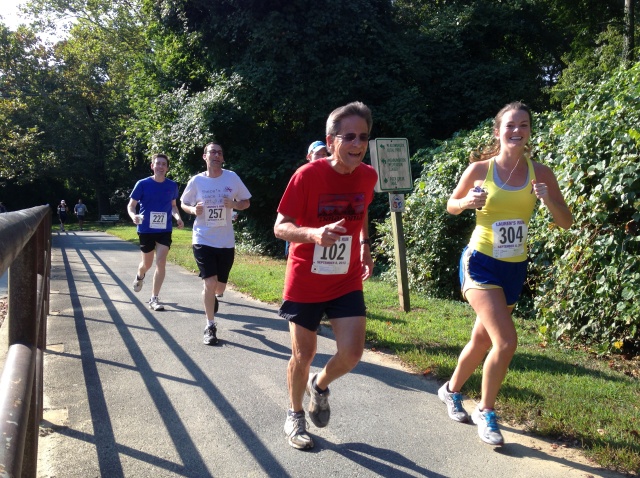
The inaugural Lauren’s Run was less of a race than a reunion. At 9 a.m., race time, the starting line in Rock Creek Park was clear as Jerry Alexander, the coach of GRC Racing Team, gave a short speech about Lauren Woodall Roady’s “indomitable spirit.”
That spirit powered Lauren’s fast rise from recreational to elite runner. But it wasn’t just running. It was the balanced yet tireless way Lauren lived her life, applying her talent and energy to her training and racing, her work as a lawyer at the Nuclear Regulatory Commission, her baking, her commitment to family and friends, and more. As one of her close friends, Jennifer Harris, who met Lauren in second grade and now lives in Connecticut, said at the event, Lauren “could multi-task like nobody’s business.”
Last December, Lauren was struck by a vehicle and killed in Lexington, Ky., hours after competing with her GRC teammates in the National Club Cross Country Championships, her first cross country race. But her 5K memorial run Sunday, organized by her GRC teammates and well attended by Lauren’s family and friends, was clear proof that her spirit lives on. All proceeds from Lauren’s Run will benefit an organization that supports Cades Cove, a valley in the Great Smoky Mountains where Lauren spent many summers hiking and camping with her family.
“It’s hard,” her father, Jack Woodall, said. “We still miss her every day. It’s great to be here and see her friends. … She had a lot of joy in her running, and that’s what you see [here].”
Jack and Sharon traveled from their home near Knoxville, Tenn., to take part in the event. They were joined by their son, Nicholas, a graduate student at UCLA, Jack’s brother, and family friends.
From an early age, Jack said, Lauren loved horses. “We knew nothing about horses,” he said, “but she wanted to ride horses so bad that she learned everything she could about them and did all that herself. And I think that really taught her a lot of organizational skills because it’s pretty complicated to go to school, and look after a horse, and ride.”
Through college and law school, Lauren’s passion for equestrian sports became more difficult to maintain. She started running recreationally, gradually re-applying her dedication to equestrian sports into distance running. In 2009, she ran her first marathon, qualifying for Boston. In early 2012, Alexander observed Lauren doing a workout one night at Bethesda Chevy-Chase High School, where the club practices, and invited her to join the team. In one of her last races, Lauren raced head-to-head at the Navy Air-Force Half Marathon with an Olympic trials qualifier, nearly breaking her personal best for 5k along the way.
This 5k, really, was about bringing people together.
When Lauren’s husband Peter Roady, a budding triathlete, told friends about the event and they in turn told him they “weren’t really runners,” Roady told them, “It’s not really about running a race. It’s about being outside, being active” – celebrating the essence of Lauren’s dedication to the sport. His good friend, Anand Prakash, who does not think of himself as a runner, was convinced to run and walk the course the day after returning from a work trip to Bangladesh.
While James Pagano of Arlington was top male in 17:14 and Michelle Miller of Damascus was top female in 20:12, participants also walked and pushed strollers. Before and after, participants and GRC members who helped put on the event gathered around the Meadowbrook Park Activity Building’s picnic tables – near the start and finish – to socialize and share memories over baked goods supplied by club members.
“It’s always great to see everyone celebrating her,” Harris said. She then added, “I think the hardest thing is, you expect to see her there. I think that still catches me by surprise.”
GRC’s Lindsay Donaldson O’Brien, Laura O’Hara, and Patrick Murphy chose to stage Lauren’s Run where they did because it was near the park’s horse stables, which the route passed twice as it looped through park roads and bike paths.
Roady, who was joined at the event by his parents, sister, extended family, friends, and co-workers, added that the race’s location was Lauren’s favorite place to run. They lived near the park and often ran the trails together. Lauren also liked to do long marathon training runs on Beach Drive, Peter said.
“If it were any Sunday morning and she were still around,” he said, “this is exactly what she would have been doing. It just probably would have been 20 miles, not [5K].”
Four years ago, Lauren inspired Peter’s mother, Celia, to start running. She completed a 5K, and has been running four or five days a week ever since. Weeks ago, at 62, she completed her first triathlon.
For Rockville’s Jeff Lynch, Lauren’s Run was his first 5k in 28 years, when he was in high school. He was one among several dozen of Lauren’s co-workers at the Nuclear Regulatory Commission who participated in the event – walking, running, getting across the finish line. Lynch and other NRC employees had learned of Lauren’s running accomplishments through an article in the agency’s newspaper.
Lynch was joined in the event by co-workers he meets at the end of the day to workout in the NRC gym, where Lauren used to sneak in a second workout on her lunch breaks.
“Maybe I’ll have to start running more,” he said.
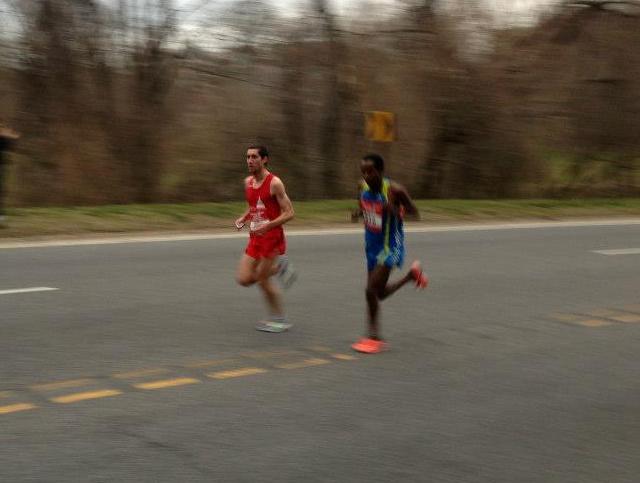
“Competitor Group is at it’s [sic] core a health and wellness company dedicated to promoting and enhancing an active lifestyle. Lifestyle is the key word, not Sport. Rock n Roll marathons have always been about the journey, the commitment, the personal dedication required to train and finish a half or full marathon. We’re not about how fast you complete the race, we’re about the fact that you showed up on the start line and the commitment one has made to complete the journey.”
The above quote comes from Competitor Group CEO Scott Dickey, explaining the company’s decision to disassemble its elite athlete program in a response to an earlier piece by Toni Reavis. Competitor puts on the Rock ‘n’ Roll half-marathon and marathon series.
This story was originally reported by RunBlogRun, which wrote on Aug. 30 about how “it was learnt” on Friday evening that Competitor Group had eliminated their support of elite athletes in the form of fees, travel, and lodging, part of a “strategic business decision that the 240,000 plus participants have little or no interest in the front of races and that the estimated $475,000 could be better used elsewhere … .”
We’d like to hear from you. Do you agree with this business decision (to be fair, as RunBlogRun described it)? Are runners whose performances have never been recognized by prize money or an invitation to stand on a podium or any kind of hardware inspired by professional and sub-elite runners? Do you think the money used to draw elite athletes could be put to better purposes? Would Competitor’s decision in any way influence your decision to sign up or not sign up for a Rock ‘n’ Roll race in the future?
You can read more statements from the Competitor Group about its decision in this story by Runner’s World, which also notes that the Rock ‘n’ Roll races will continue to offer prize money and maintain relationships with elites such as Ryan Hall and Kara Goucher.
Changes to the Marine Corps Marathon course are exciting local runners and likely going to mean faster times this October.
Runners will not have to endure a big hill around the Georgetown Reservoir between miles seven and eight. Instead, from miles six through nine, runners will run up Rock Creek Parkway to the bottom of Calvert Street and back, a stretch used in the Navy and Nike Women’s half marathons, as the MCM course returns to a pre-2007 design.
Race director Rick Nealis said in a press release that the new course offers “more spacious and flatter roadways.”
“Georgetown,” he added, “especially M Street, remains important to our runners and, annually, the hot spot for spectators and supporters.”
Previously, runners turned left onto Canal Road off of the Key Bridge to Georgetown on the way to the big climb up Reservoir Road into the Palisades, past the Georgetown Reservoir and down McArthur Boulevard and Foxhall Road. On the new course, runners will hit Georgetown’s M Street earlier in the race, in mile five, before they head down to Rock Creek and Potomac Parkway and then around Hains Point.
Another change, though minor, occurs late in the race as runners loop around the National Mall. The marathon will now cover 3rd Street to Constitution Avenue. It previously routed through a parking lot on Pennsylvania Avenue alongside the Capitol reflecting pool.
Public Relations Coordinator Tami Faram said MCM organizers “made an operational decision to make the course both safer and more scenic.” Rock Creek and Potomac Parkway had been a part of the race course from 2001 to 2006.
In 2007, MCM had 20,622 finishers, about three thousand less than in 2012. The growth in participants, Faram said, made the hairpin turn at Canal Road both more difficult and congested.
In one of George Banker‘s binders packed with Marine Corps Marathon results, notes, clippings, and other assorted memorabilia, the race historian has a page of splits from the 1987 race. While the MCM historian can’t recall who gave him these splits, he knows they correspond to Jeff Scuffins‘ course record-setting victory in 2:14:01. (Scuffins went through halfway, according to Bankers’ notes, in 1:06:49. Conditions were actually less than ideal, with a rising race time temperature of 60 degrees.)
Banker, who has run MCM 28 times, was nice enough to dig through this binder recently when we asked him what he thought about flatter course. As Banker recalls, the course when Scuffins set his record, had runners starting on Route 110 in Virginia and heading south in Crystal City up 15th Street. You would end up looping back across the starting line at about 7 miles and take Route 66 over the Key Bridge to Georgetown’s M Street, he explained.
Back then, you hit Mile 20 out on Hains Point; the one real hill was behind the U.S. Capitol on C Street.
“That was definitely a faster course,” he said. “I would say, after that” – as construction and other factors began to require route changes – “they all become a little more difficult.”
Does MCM returning to its pre-2007 design – sending runners out-and-back on Rock Creek and Potomac Parkway – make it a significantly faster course?
Two-time winner and RunWashington contributor Jim Hage told the Washington Post, “Anytime you can knock out some hills it’s a good thing.”
Two local runners aiming to set new personal bests in the marathon agree.
Michael Rohlf, who ran MCM from 2010 (his first marathon) through 2012, said he paid the toll of those early hills later in the race. The hills, he added, also made it tough to settle into a good early rhythm.
In his first attempt to break three hours last fall, Rohlf tired late in the race, he said, and ran 3:12. This fall, in an attempt to achieve his goal, he signed up for the Philadelphia Marathon, which he figured would give him a better shot.
“But now that the MCM course has been changed, and in my opinion improved, I really look forward to running it again – maybe next year,” he said.
Colleen Lerro is entered in her third MCM this year and hopes the course change will give her a better shot at qualifying for the Boston Marathon. She ran her first MCM in 2006, before the course change.
If Lerro does not achieve her goal this year, she will be “much pickier next year” and choose a flatter course.
Regardless of the layout, though, MCM is Lerro’s favorite marathon, and “the course I would love to get my BQ on,” she said.
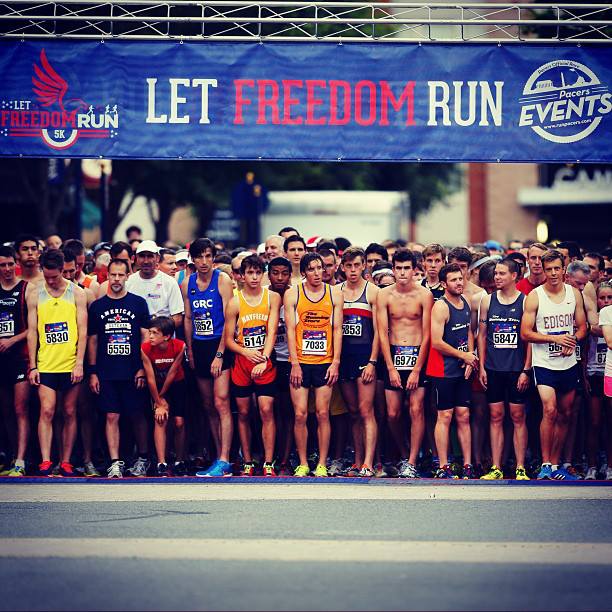
Ansley Howell seems ready for a real pair of running shoes. The 8-year-old from South Riding – running with tiny American flags behind her ears – was third in her age group this morning at the third annual Let Freedom Run 5k in Fairfax.
[button-red url=”http://results.bazumedia.com/event/results/event/event-4601″ target=”_self” position=”left”] Results [/button-red]Howell was paced by her father, Gregg, while her sister, Grace, 12, was paced by her mother, Ann. Her older brother, Noah, 14, who runs cross country for Freedom High School – “too fast for the rest of the family,” Gregg said – was on his own, finishing around 20 minutes.
“We do a lot of 5Ks together,” Gregg said. “My wife and I have done marathons, and our two older ones are running cross country, so running is a big part of our lives.”
The Howell family were among 1,304 finishers. And on Independence Day, a holiday generally filled with relaxing, trips to the pool, cookouts, and fireworks, Gregg said they could think of no better way to start the day.
“We just wanted to do something together,” Gregg said, “and [running a race] is the first thing that comes to mind for us.”
Same for Dixon Hemphill of Fairfax Station, and his son and grandson, Peter and Joshua, who live in Centreville. You kick off a long weekend with a race – a sense of accomplishment – and from there everything else just falls into place.
“We’ll go out to breakfast,” Peter said, “that’s the first thing we’ll do. Then we’ll go home, take a shower, relax.”
Dixon started running at 50, he said, and has been at it for close to four decades. He has been running races with his son for many years, and now the tradition is being passed on to Joshua, who this morning finished his fourth 5k at a time of about 35 minutes with his dad at his side. Peter, special for the nation’s birthday, sported a pair of Texas-themed red, white, and blue racing shorts.
In the lead packs – on an overcast, humid morning – the defending champs were back to defend their titles, with Jordan McDougal aiming for a three-peat.
McDougal, of Linden, Va., ran his best time yet for this race, 15:43, but had to settle for second to Paul Thistle, 26, of D.C., who won in 15:30.
The top four places on the men’s side were all under last year’s winning time of 16:06. The top master, Rockville’sJean–Christ Arcaz, came through in 18:03.
On the women’s side, last year’s winner, Manassas’ Bethany Sachtleben, a rising sophomore at George Mason University, took an early lead and went on to clock 17:53, more than 30 seconds under her winning time from 2012.
When Barb Fallon Wallace, 39, of Alexandria, reeled her in, the veteran local road racer knew she’d better keep pushing.
“I knew that she had been running in college … I didn’t want to get in a kick with her,” she said, laughing.
Little more than a year ago, Fallon Wallace ran a new personal best for 10k not long after giving birth to twin girls. Wallace’s daughters are now two, while her 10k personal best is now about a minute faster.
Alisa Harvey, who was 2nd in the inaugural race, returned this year to finish 3rd overall and win the master’s division. Harvey, 47, of Gainesville, finished in 19:07, not much slower than what she ran in 2011.
The 5k starts and finishes at the same spot in Fairfax Corner Shopping Center, and is held on a rolling, challenging course. Afterward, runners and families gathered for refreshments, treats, and dips in the water fountain. And regardless of whether you attended the packet pickup-slash-beach party at Pacers Fairfax on July 2, participants, rather than a free t-shirt, received a colorful beach towel to kick off summer.
The usual plan for the George Washington Parkway Classic calls for securing a 10-mile, point-to-point course that starts at Mount Vernon, proceeds along George Washington Memorial Parkway, and finishes in Alexandria – a short walk away from Oronoco Bay Park. This means, on one hand, that some sort of barrier must stand between every driver and every possible opportunity to unknowingly or knowingly enter the race course. On the other, it means that course marshals and police officers must be ready to stand by and enforce these barriers; and, should the unthinkable happen – a vehicle on the course – the plan includes being ready for that, too.
There is the job of safely transporting 6,000-or-so runners from an area near the finish – where many park – to the start. There is the readiness for any on-course injuries. There are risk management strategies. And yes, there is water, and sports drinks, and gel packs, and clocks at mile markers.
That’s not it – not even close. But two more things: The Alexandria Police Department, for this year’s race, wanted to honor a colleague who was seriously injured in a shooting, and, on a related note, make the last mile special for participants.
Twenty-five year force member Sgt. Joseph Seskey and the members of his special events unit envisioned – with about a mile to go – a line of police officers there to greet the runners, many of whom wore honorary bibs for Officer Peter Laboy, the man injured, on their backs. “So you turn that corner,” Seskey said, “and it kind of grabs you: everyone coming together to support Peter.”
Six days before the Parkway Classic, tragedy struck the Boston Marathon.
An hour later, Seskey was on the phone with Kathy Dalby, founder of Pacers Events, which organizes the race.
The officers scheduled to stand strong for Peter Laboy were reassigned to other race day duties. Contingency planning for “enhanced security,” years in the making, quickly took shape.
“We knew we had to make some changes,” Seskey said, “and be out in front. Within an hour from Boston … everybody was thinking alike. We all just knew what we needed to do.”
In addition to Alexandria police and Pacers Events, “everyone” included U.S. National Park Police, whose jurisdiction covers better than three quarters of the course, fire and rescue units, and additional local and federal agencies whose services were suddenly in high demand.
Sanitation was called in to cover trash cans. Emergency management, intelligence, and special operations performed unseen jobs. The finish area was closed off to spectators, a mobile command center situated nearby.
Staffing was increased for specific locations, Seskey said. Extra bomb-sniffing dogs were present. Snipers manned rooftops, while extra police teams observed the crowd.
“We have always understood that any place that a lot of people assemble could be a possible target,” said Seskey, whose team is handling safety and threat assessments plans for an ever-increasing number of road races. “You just have to always be prepared. We kind of operate on that level without even knowing it, just because we have been doing it for so long.”
The Game Changer
What if there is a huge thunderstorm, or a gas leak, or an attack? How would you re-route or cancel the race? What’s the evacuation plan?
When police, fire departments, emergency services, and race organizers meet at the planning table months before an event, all these scenarios are on the table, Dalby said.
Twenty years ago, Marine Corps Marathon Race Director Rick Nealis remembers one thing that weighed heavily on many race directors’ minds was whether to put four or six ounces in the Dixie cups Marines would hold out for runners.
September 11 was a “game changer,” he said, explaining the increasing emphasis placed on safety and security rather than water, Vaseline, and bananas.
As if September 11 wasn’t enough, the D.C. sniper shooting occurred the follow October. The next year, America entered a second war, making MCM a potentially more inviting target, Nealis said.
There was a time when MCM runners could park in the Pentagon parking lot, a time when race day logistics didn’t include security checkpoints. There was also a time when the race didn’t sell out in less than three hours.
While you run MCM – through seven police jurisdictions – emergency crews are on standby, security alerts are taken and processed, police officers stand guard over barricades.
Some situations require quick decisions. During last year’s MCM 10K, which is held during the marathon, debris left over from the Army Ten-Miler, Nealis said, blew onto the course and looked like a suspicious package. The race was stopped until authorities could inspect it.
Afterward, while you analyze every last detail about your performance, so do organizers and their security partners.
“Each year,” Nealis said, “you sit back and you say, well, we could do this better.”
Enhanced Security
Jean Arthur remembers how quickly one driver’s irritation turned to rage.
She was standing beyond the sidelines of a local road race, a volunteer course marshal. The road was closed for the race, Arthur explained to the driver. The only option was to turn around.
The driver started yelling. A police officer, who heard the yelling, approached the car, and suddenly the driver seemed to have no problem at all.
Arthur is now the race director for the Pikes Peek 10k, a point- to-point, super-fast race, held this year on the same day as the Parkway Classic.
She took over the job in 2007. By now, she knows all of the police officers she works with on a first name basis.
For Pikes Peek she works with several police departments and two fire departments.
The traffic control plan is 50 pages long. And in the early morning, as a race truck heads out on the course to lay down cones, a police car follows with flashing lights.
Going back to her experience, Arthur has learned that police bring more than manpower to an event, but also a sense of legitimacy. Drivers encountering a truck going really slow on Route 355 in the early morning sometimes become annoyed, and having a police officer at her side provides “general protection.”
After she heard about the attack in Boston, Arthur contacted her event partners right away.
“Hey, Jean,” one police officer wrote her in a text message. “I got you covered. We’ll take care of you.”
Bomb sniffing dogs were at the start and finish of this year’s race, sniffing vehicles, bags, and portable toilets. An extra police officer roamed the course on a motorcycle.
Police officers at Pikes Peek, once on-course assignments are complete, typically report to their next assignment, but this year all of them provided extra security at the post-race festival.
“I think from here on out we have to take these extra precautions,” Arthur said.
Even so, how much will really change?
When you run a race in the District starting in front of Freedom Plaza, you probably aren’t thinking – are you even aware? – of the hundreds of cameras watching you, of “mass casualty” pre-planning, or reports of a suspicious car near the course.
Enhanced security, much like regular security, is both seen and unseen. So as race organizers and police officers, post-Boston, re-evaluate these plans, now is a good time to recognize how much safety and security infrastructure is already in place. This is the time to recognize all the planning that goes into closing roads so we can race in the middle of them, and the already essential role of police and fire crews and medical staff and emergency response units in allowing us to celebrate our sport.
The Parkway Classic was U.S Park Police Sgt. Ari Wong’s first race as head of the force’s special events unit.
“Coming into this job,” Wong said, “you really don’t have as much appreciation for what goes into it.”
For big races like the Parkway Classic, the planning begins many months in advance. Thus, by race day, every assigned officer’s task should be clear. “I do my job well,” Wong said, “if I don’t have very much to do on race day.”
Given the sheer volume of road races in the area, the job, Wong said, comes with its fair share of super-early weekend mornings.
But Wong, and Seskey both said they enjoy the work, and working with each other, on races that cover both police forces’ jurisdictions.
“There’s no lead agency,” Wong said. “We work together from day one.”
He added: “For all of us in law enforcement, the people running are our neighbors, our friends, our colleagues’ husbands and wives. We want it to be a special event for them. We want it to be safe.


